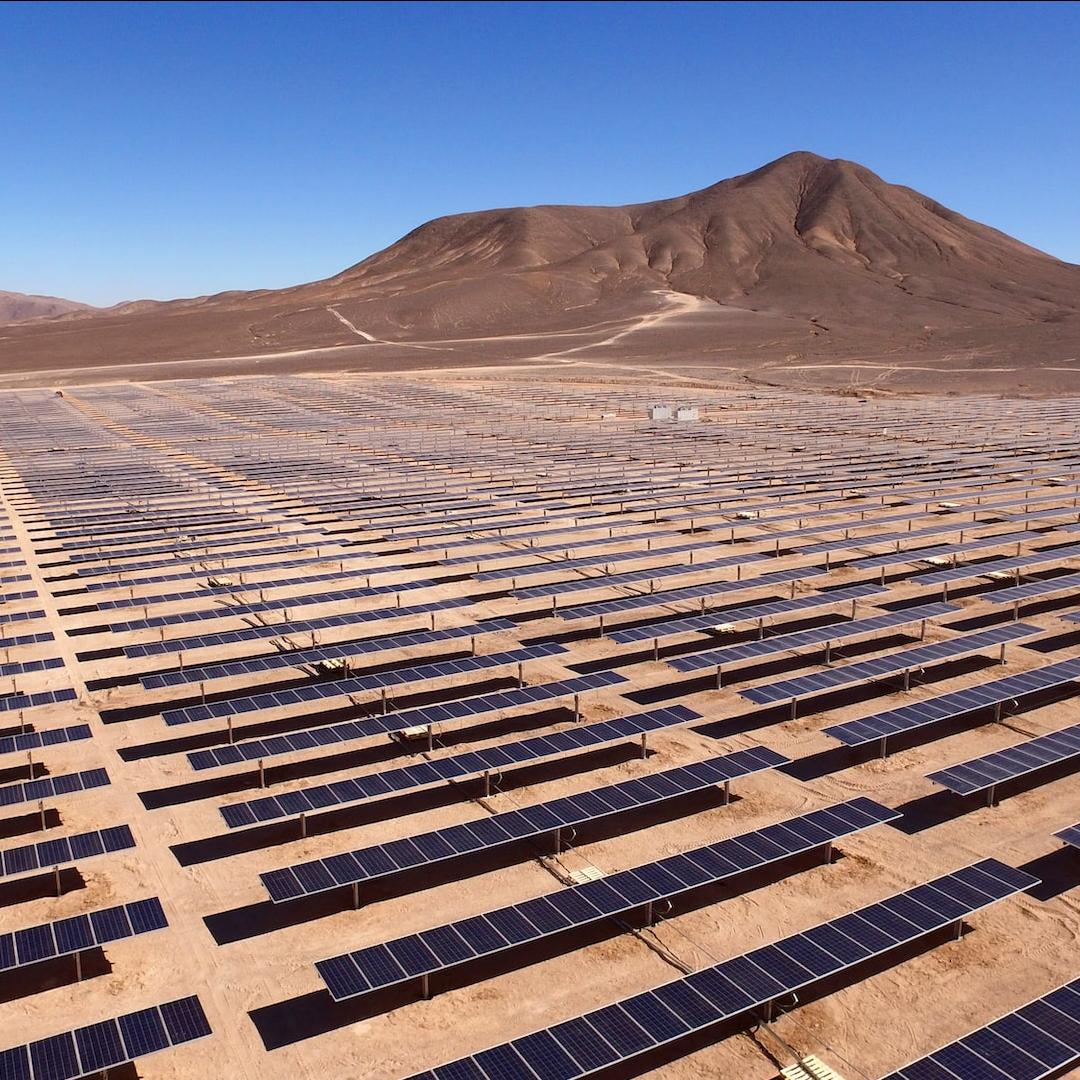COP27 a Reminder That Swapping Out Debt for Conservation Funding Has Big Potential, But It’s Not Perfect


A major topic at this year’s global climate summit has been finding sustainability and conservation funding solutions for developing countries that are already saddled with debt and therefore unable to invest in protecting their natural environments — with debt-for-nature swaps emerging as a promising path to halting biodiversity and ecosystem loss. At COP27, The Nature Conservancy hosted one such panel from the Nature Zone Pavilion — an area set aside for discussions related to the worldwide objective of ending nature loss now and beginning to reverse it by 2030, known as Nature Positive.
From the information presented at “Greening Sovereign Debt: Addressing Dual Crises of Climate and Debt,” debt conversion for conservation appears to be a game changer as far as funding initiatives in the Global South are concerned. However – since investors are motivated in large part by the opportunity to get closer to their net zero commitments – these funding mechanisms also represent a lack of real action to drastically reduce emissions in the Global North. The hard truth is, if the planet is to remain habitable, then world leaders cannot focus solely on preserving nature in the developing world in order to excuse the actions of corporations and more developed nations.
That’s not to say that there isn’t a lot to gain from the conservation funding model. Rather, there is a legitimate and sizable benefit to be had by countries that can take advantage of trading their sovereign debt for conservation funding. Andrew Deutz, the Director of Global Policy, Institutions and Conservation Finance at the Nature Conservancy, opened the discussion with this point: “The world is facing a debt crisis. The world is facing a climate finance crisis. And these two crises need to be solved together.”
While debt-for-nature swaps have been around since the 1980s, Jennifer Morris, CEO of the Nature Conservancy, referred to this year’s climate summit as the implementation COP for the “Holy Grail” of private sector funds that are flooding in for conservation. She also referenced the 60 percent of low-income countries that are in or near debt distress, asking the obvious question — how can they be expected to afford investments in sustainability development?
Part of the answer could lie in $10 billion worth of debt conversions for the countries that have already approached the Nature Conservancy for assistance, which would result in $2 billion for their conservation efforts, according to Morris. Success stories from the organization previously partnering with private capital to fund debt-for-nature swaps in the Seychelles, Barbados and Belize were given as examples of the power of financing sovereign debt relief as a catalyst for conservation. She touted the $230 million that was made available for conservation and sustainability efforts in the three countries following $500 million worth of debt conversions. Additionally, marine conservation commitments that came out of the arrangement amounted to almost 200,0000 square miles (about half a billion square kilometers) being protected.
“We used private capital with these credit enhancements to do that,” Morris explained. “It didn’t require a huge grant from the Germans or the French or the Norwegians. We were able to do that with private money. So that is the genius of this model.”
Likewise, Scott Nathan, CEO of the US International Development Finance Corporation (DFC) said, “This is about bringing private capital, opening up the private markets, innovative solutions, tapping into the depths of the private capital markets to help solve these problems.” He extolled the success of the DFC’s partnership with the Nature Conservancy in applying a debt-for-nature swap to Belize, which resulted in a debt reduction of $180 million for the Central American country while providing money to double its protected marine area, support conservation efforts for the Belize Barrier Reef, implement new mangrove reserves, support biodiversity, protect livelihoods, promote tourism and preserve the fishing industry.
Jean-Paul Adam, the Director of the Climate Change & Natural Resource Management Division for the United Nations Economic Commission for Africa, worked on the debt-for-nature swap for Seychelles. While he mentioned that the debt relief was smaller than they originally wanted, the African nation went ahead with it because it fit their marine conservation plan for eco-tourism and sustainable fishing. Doing so allowed for a trust to be set up which has funded conservation projects since 2016.
When asked by an audience member why the debt needs to be leveraged instead of just forgiven, Adam responded that while that option is being considered at the international level for those that are in the worst debt, he sees supporting developing nations in refinancing as a positive move with practical outcomes.
One big positive to refinancing is that the new loans can come with hurricane and natural disaster clauses that suspend payments for up to two years, according to Juan Pablo Bonilla, Climate Change and Sustainable Development Sector Manager at The Inter-American Development Bank. He also mentioned that refinancing can lead to credit enhancement, which many countries would want to take advantage of in order to accelerate their sustainability programs.
Still — relying on the private market has its pitfalls. While Sonja Gibbs, the Managing Director of Head of Sustainable Finance at the Institute of International Finance, estimated that $800 billion could be available annually for debt conversion, she also conceded that funds depend on favorable market conditions. Naturally, scaling up the model is dependent on the returns seen by the private sector. And with ESG on the chopping block for the coming economic downturn, depending on private investment could be risky business.
Overall, debt-for-nature swaps have the potential to promote conservation funding and sustainability in developing nations while relieving the burden of sovereign debt. This could go a long way toward preserving the natural world in the Global South. But, if we are going to have any hope of slowing the crisis, the Global North will have to do a lot more than just throw money at the climate crisis.
Image credit: John Salzarulo via Unsplash
How One Tech Giant Is Ramping Up Clean Energy Access for More Citizens Worldwide


IBM has announced the addition of five new members to its global pro bono environmental program for non-profits, the IBM Sustainability Accelerator, which applies IBM technologies, such as hybrid cloud and artificial intelligence, and offers a team of experts to develop clean energy and technology projects to help populations particularly vulnerable to environmental threats including climate change, extreme weather and pollution.
The combined impacts of the COVID-19 pandemic, disruptions to global supply chains, the energy insecurity caused by Russia’s invasion of Ukraine, and the diversion of public resources to keep food and fuel prices affordable together have hindered the pace of progress toward the SDG 7 goals, according to the International Energy Agency. The poorer a nation or a community are, the more vulnerable they are to natural disasters and climate change. According to the World Bank, natural disasters force 26 million people, roughly equivalent to the population of Cameroon, into poverty each year.
“With the IBM Sustainability Accelerator, we are convening experts and using innovative technologies to help tackle the toughest environmental challenges our planet faces; and transitioning to clean energy is a critical step right now,” said Justina Nixon-Saintil, vice president of corporate social responsibility and ESG at IBM, in a public statement.
Helping marginalized communities get “just and equitable access to sustainable energy resources” through this new cohort not only helps the world achieve the goal of the United Nations Sustainable Development Goal (SDG 7) of ensuring access to affordable, reliable, sustainable, and modern energy by 2030, it can “help the larger global energy transition,” said Nixon-Saintil.
IBM announced these additions to the Sustainability Accelerator at COP27 in Sharm El Sheikh, Egypt. The new members, which were selected from more than 100 applicants, form a new cohort for the program focused on accelerating clean energy projects. (The Sustainability Accelerator’s first cohort is focused on sustainable agriculture.) The organizations were chosen because of their current engagement with vulnerable communities, their ability to improve access to affordable clean energy services and their strategic focus and transparency on measurement and reporting.
The United Nations Development Programme is working with IBM to increase access to sustainable, affordable and reliable energy in several African countries, focusing on those furthest left behind. Using UNDP’s technical knowledge and IBM’s expertise in artificial intelligence and geospatial analytics, the goal is to forecast electricity access to better guide policy and investment decisions.
The international NGO Sustainable Energy for All and IBM are teaming up to build an intelligent model to project energy needs based on current and future human activity. The model will be designed to help to address key development challenges such as lack of energy access and poor healthcare, and support the development of robust infrastructure planning, such as electrification plans. IBM will develop open-access datasets and an energy needs model using temporal and spatial data. Kenya and India are being considered as the first regions for pilot projects.
IBM and Net Zero Atlantic of Canada are collaborating to create an interactive digital tool that will geospatially display environmental and socioeconomic impacts of possible energy system futures for Nova Scotia. The long-range goal is for Indigenous communities in Nova Scotia to leverage advanced modeling capabilities to inform their input into energy and development planning. The tool aims to be easy-to-use, locally relevant and time efficient.
The city government of Miyakojima, Japan is working with IBM to support the development of a renewable energy strategy including a microgrid on Miyakojima Island, a remote community especially vulnerable to typhoons. The goal is to help their residents, who rely on a clean local environment for the tourist industry and agriculture. Miyakojima City Government and IBM will collaborate to leverage IBM technologies to model electricity demand and advise energy infrastructure development.
The Environment Without Borders Foundation is collaborating with IBM to develop a platform to forecast, track, and communicate clean energy usage options in Egypt. The goal is to enable resilient and sustainable infrastructure and operations for clean energy in Egypt, helping residents of remote locales where energy is currently both expensive and unreliable.
In February, IBM announced it plans to select five non-profit organizations for the accelerator annually and expects to provide $30 million worth of services by the end of 2023.
Image credit: Antonio Garcia via Unsplash
Discharged and Displaced: Breaking the Military-to-Housing Insecurity Pipeline


Much like many other signs I’ve seen, this one outside the New York city subway says “Homeless Veteran. Please Help.” It pains me to see yet another fellow veteran who has fallen through the cracks of an extremely broken system – who hasn’t been afforded the same protection they’ve provided for their country by risking their lives every single day.
On any given night, an estimated 40,000 veterans go without shelter in the United States. Additionally, about 1.5 million veterans are considered at-risk of homelessness. According to Iraq and Afghanistan Veterans of America’s (IAVA) most recent member survey, 23 percent of respondents didn’t have a permanent place to live when they transitioned out of the military, out of which 77 percent reported couchsurfing temporarily.
These statistics reflect the frightening and challenging reality of the veteran housing crisis, which has been exacerbated by the COVID-19 pandemic. Due to the nature of veterans’ service, this community faces unique challenges during their transition back to civilian life, which perpetuates a military-to-housing insecurity pipeline.
In order to break this pattern, we must combat all the leading contributors of homelessness – unemployment, lack of affordable housing, substance abuse, mental health challenges, and many more – through a holistic approach that employs a clear understanding of their interconnectedness.
Employment
One of the most obvious shifts that veterans face post-service is a change in employment. While veterans spend years in the military upgrading their skills in particular fields, these skills are not always transferable to the civilian labor force. This is a significant impediment to veterans during their transitional period.
What’s more, veterans are often subject to increased scrutiny from employers. The reluctance of employers to hire those with the possibility of deployment (for individuals continuing their service in the Guard and Reserves) as well as veterans with disabilities – despite legal requirements against such discrimination – affects employment opportunities. Further, they may not have the qualifications, such as a diploma or certificate, which are often required to obtain a position. This has resulted in a combined under-employment and unemployment rate of 61 percent for transitioning service members and veterans.
These veteran-specific barriers to full employment have a direct impact on housing insecurity. The inability to secure employment results in the lack of a reliable source of income, which hinders veterans’ capacity to apply and pay for housing.
Affordable housing
Only 36 affordable and available rental homes exist for every 100 extremely low-income renters – creating an overall shortage of 7 million affordable rental homes nationwide. Uncertain income in addition to lack of affordable housing creates a vicious cycle of housing insecurity. Moreover, 2017 census data showed that more than 660,000 veterans living in low-income households still spent more than 50 percent of their income on housing. Veterans in this situation are at a higher risk of being evicted or experiencing homelessness, with countless individuals forced to make impossible decisions on whether to pay for housing or other necessities like food.
While many short and long term housing instability solutions and prevention services have been implemented, they are often underutilized and often unequipped to address the complex needs of veterans who have experienced homelessness for long periods of time.
Physical disabilities and mental health
As previously mentioned, injuries among returning service members can lead to housing insecurity if they do not have adequate support networks. Overall, 53 percent of individual veterans suffering from homelessness have disabilities, compared to 41 percent of non-veteran individuals without shelter. Additionally, medical bills due to these injuries can begin a chain reaction that eventually leads to homelessness.
Fifty percent of veterans experiencing homelessness suffer from serious mental illnesses. Mental health challenges often exacerbate veterans’ isolation from communities despite the need for community support to navigate living with a disability and accessing care, which can compound the housing insecurity cycle.
Physical disabilities and mental illness often go hand-in-hand with substance use disorder (SUD). For example, veterans who have been prescribed opioids for pain management as a result of a service-related injury are at risk of abuse and, in turn, addiction. Additionally, 37 to 50 percent of veterans who served in Afghanistan and Iraq were diagnosed with a mental health issue associated with SUDs and 63 percent of those diagnosed with SUDs also met the criteria for PTSD. Veterans who are dealing with SUD or who have been incarcerated as a result of substance abuse issues are often unable to participate in housing programs.
Where do we go from here?
One such solution that addresses the intersectionality of housing issues is the Building Solutions for Veterans Experiencing Homelessness Act of 2021. This bill would strengthen programs emphasizing permanent solutions to housing instability and homelessness experienced by veterans across the country and preserve expiring COVID-19 related housing programs.
Among the many critical solutions in this bill, this legislation would provide greater accommodations for veterans experiencing homelessness by permanently removing barriers on funding for construction of transitional housing, expanding public transportation for veterans to access physical and mental healthcare and delivering appropriate medical care for aging veterans while they await long-term care placement, and increase and make permanent funding connecting veterans with long-term jobs.
Current programs from veteran service organizations (VSOs), such as IAVA’s Quick Reaction Force (QRF) which helps veterans navigate housing programs based on their needs and preventing evictions – would also be enhanced by this legislation.
The problem of homelessness is perceived by some as a personal moral failure, not a systemic problem that has led us to abandon the most vulnerable in our society. It takes concrete actionable solutions from society, as a whole, to end homelessness. By expeditiously passing the Building Solutions for Veterans Experiencing Homelessness Act, our policymakers can make historic gains in eliminating the veteran housing crisis.
Interested in having your voice heard on 3p? Contact us at [email protected] and pitch your idea for a guest article to us.
Image credit: Benjamin Faust via Unsplash
COP27: Building a Regenerative Economy Through a Just Transition


COP27 at Sharm El-Sheikh, Egypt, on Nov. 6
As the sustainability world drowns in an alphabet soup of ESG, CSR, and a multitude of other industry acronyms, at COP27, one concept that the international trade union movement has long developed and promoted is now being embraced by businesses, NGOs and governments to describe climate action plans that are socially equitable, financially viable and environmentally regenerative: a just transition.
A just transition seeks to encompass the concepts of human rights, circularity, poverty alleviation and the environment. One of the only six high-level round tables for world leaders was dedicated solely to discussing such a transformation, as well as an entire COP27 event pavilion. During the conference, representatives from financial institutions, industry and NGOs have been discussing their organizations’ contributions to a just transition in an array of panels and lectures.
More governments and businesses are embracing the shift to a just transition
At COP26, over 30 countries including the United States, Canada and the European Union signed the Glasgow Just Transition Declaration, which aimed to “deliver sustainable, green and inclusive economic growth to meet the challenge of decarbonizing our economies, in line with limiting the global average temperature increase to 1.5°C above the preindustrial levels.”
Countries that signed the declaration committed to supporting workers vulnerable to the economic effects of decarbonization, increasing engagement among governments, employers, and workers’ groups affected by a green energy transition, and implementing policies to expand clean energy and foster inclusive economic growth that respects human rights. Many corporations have followed their national governments’ lead to include such policies and procedures into their overall business strategies.
Haley St. Denis, whose title is head of just transition at the Institute for Human Rights and Business (IHRB), is encouraged by the number of companies embracing the concept of a just transition. During one side event, St. Denis said, “A lot of the guides on just transition are targeting governments to help them establish just transition frameworks. It’s not clear what’s expected of businesses yet, and it can be scary to stick your head above the parapet.” She noted that engaging the private sector is key to ensuring inclusive economic growth.
Why finance must support this movement
Maria Simonson is the Head of Sustainability at Swedish Export Credit Company (SEK), a state-owned company that finances Swedish exporters. She believes that a just transition model will soon be the norm in the European Union. During an event about this focus at COP27, she said, “Increasingly, the just transition is coming in through regulation in the E.U., and it’s going to be hard-wired into the financial system.”
Discussions at a just transition roundtable on November 7 echoed Simonson’s ideas. Discussions centered on working to ensure consistent finance for this shift, exploring finance opportunities available from the private sector, and what financial institutions need in order to increase funding availability for such programs.
Simonson said, “The just transition is about recognizing our values, and we are working to integrate them into our analyses and policies, and also into our financial products. For example, we finance a lot of infrastructure projects, and human rights are relevant to that. Pollution is relevant, because pollution is a human rights issue. Our starting point is that we work with sustainability from a holistic perspective. This is part of our due diligence process.”
Moving forward with a just transition
St. Denis believes that moving forward, it is important for businesses and governments to ensure that a movement to a just transition does not lose its meaning. She warned, “We are seeing an increase in misuse of this visionary concept. Just transition has already become an acronym. The term could become meaningless, because if ‘JT’ can mean everything to everyone, then it will mean nothing at all. We challenge everyone in the room: if ‘JT’ is not going to go the way of CSR and ESG, then we have to develop means of quality control for what ‘just’ in just transition means.”
Talks and events about this framework are expected to continue throughout the remainder of COP27, which runs from Sunday, November 6 to Friday, November 18.
Image credit: UNFCCC
Cultural Changemakers Have a Powerful Role in Promoting Climate Action


Photo: Panelists talk at the Nest Summit Campus NYC Climate Week event earlier this fall. The panelists, from left to right, are: Westley Schultz, co-founder of and lead vocalist for The Lumineers; Colin Wilson, retired player for the NHL's Nashville Predators and Colorado Avalanche; Sofi Armenakian, Head of Sustainability for the Atlanta Hawks and State Farm Arena; Erik Distler, VP of Sustainability at AEG; and Cassie Lee, CEO of Sound Future
With popular bands embarking on months-long tours and sports teams traversing to away games dozens of times each season, sustainability may not first come to mind when thinking about the events and entertainment industry. But leaders in the sector — from athletes and musicians to executives — are hoping to reshape that narrative through awareness-building campaigns and climate action initiatives.
A panel of experts took center stage at the NEST Summit Campus during New York’s Climate Week this fall to discuss the role of cultural changemakers, and the broader entertainment industry, in promoting climate action and environmental sustainability. Cassie Lee, CEO of Sound Future, a nonprofit deploying environmental solutions for the live event industry, said the gathering power of events “should do good and can do good.”
Events have the potential to be unrivaled social agents and cultural connectors that inspire feelings of camaraderie and a push for positive change. “In this industry, we have the opportunity and responsibility to bring people along, make sustainability inspiring, and make it a little more engaging than what you find in the news on a daily basis,” said Erik Distler, vice president of sustainability at AEG, the world’s leading sports and live entertainment company.
As the host of more than 160 million people across 22,000 live events last year, AEG’s international reach presents an opportunity to bring its fans along the company's journey toward making a more positive impact on the planet.
Sofi Armenakian also sees the power of fan engagement firsthand in her role as the head of sustainability for the NBA’s Atlanta Hawks and State Farm Arena. In April, the Hawks’ home at State Farm Arena became the world’s first sports and entertainment venue to earn zero-waste certification. In less than two years, the arena went from diverting just 10 percent of all waste from landfills to diverting a minimum 90 percent of all waste from the roughly 175 events it hosts annually.
Armenakian credits partnerships as the key to driving sustainability success. “We all know there’s a real crisis. We all know we need to take action,” Armenakian said. “In order to take action and make the needle go in the right direction, we really need to partner up and collaborate and truly meet people where they are.”
Fan engagement and collaboration among industry stakeholders is also key to the Sports for Climate Action Framework — which challenges industry stakeholders to leverage sports as a "unifying tool to drive climate awareness" among the public. Launched in 2018 by industry leaders together with the United Nations, the Framework now includes over 100 signatories, including AEG sports teams like the Los Angeles Kings and Los Angeles Galaxy as well as leagues like the World Surf League, National Basketball Association, and Formula E.
On the live entertainment front, The Lumineers — a Grammy-nominated band co-founded by vocalist Wesley Schultz — are among those leading the way in this space, headlining one of the world’s first “climate-positive” tours in 2020.
The Lumineers’ 2022 Brightside World Tour replicated this climate success and featured a stop at Atlanta’s State Farm Arena in August. The band and arena partnered to offer fans who recycled the chance for seat upgrades, autographs, and other prizes. Schultz joined the panel in New York and said that although tours are “inefficient by nature,” there are ways to meaningfully lessen impact — for example by offsetting a tour’s carbon footprint, eliminating single-use plastic bottles and powering down the buses during shows.
While music stars like Schultz and sports athletes like former NHL player Colin Wilson, who also spoke on the panel, have powerful roles to play in changing the conversation, Distler of AEG said, it's also important to celebrate the “true sustainability leaders” — the back-of-house efforts and staff who sort through waste bins, replace halogen lighting with more efficient LEDs, and make these incremental changes at venues possible.
For its part, AEG has moved to reduce waste at venues and was among the first entertainment companies to adopt a science-based emissions reduction target in 2016, to then more aggressively revise the target in 2019 in accordance with updated guidance on global warming and more stringent emissions standards. The company continues to report on its public-facing targets and sustainability program to communicate progress to stakeholders and fans, and also to discuss challenges, issues needing addressed, and what hasn’t been solved, Distler said at Climate Week. Transparency, accountability, and focusing on progress over perfection is important to AEG, he added.
Overall, the journey toward sustainability in the sports and entertainment sector — which began with stadium recycling bins and evolved to zero-waste commitments and net-zero emissions trajectories — is far from over. But leaders are moving the needle with ambitious targets, holistic programs and by inviting the fans to join the experience.
“We were on a journey to become zero-waste, but now it’s a forever journey,” Armenakian said. “There is no finish line.”
Image credit: AEG
We’ve Got the Chance to Win Consumers Over on ESG — But We’re Not Communicating It Right


For years, companies have embraced corporate responsibility, then sustainability and now ESG (environmental, social and governance). For the most part, it’s the same bag of goods, only with different packaging. That isn’t necessarily wrong or bad, especially if the outcomes are better for people, profit and the planet.
Today’s challenge, however, is that just when the business community has found a way in which to explain this work, now it's finding that ESG is under attack — and although yesterday's midterm elections, as of press time, hardly amounted to a "red wave," many business leaders will still have their doubts about the ESG movement's viability.
But ESG isn't doomed. If anything, companies have the opportunity to win over consumers, i.e., hearts and minds, with their ESG strategies. Why? Well, to start, a recent Fordham University survey found that about two-thirds of all consumers are still by and large unfamiliar with ESG. But despite that unfamiliarity, they are willing to hear more anecdotal stories about their companies’ ESG efforts and could reward them with more purchases and increased loyalty.
The problem, however, is that many companies are getting the communications part of this all wrong — and they will want to rethink how they talk with key stakeholder groups, starting with consumers.
Editor's note: Be sure to subscribe to our Brands Taking Stands newsletter, which comes out every Wednesday.
“The reality is that sustainability and corporate social responsibility are inherently easier concepts for consumers to understand and embrace than are the environmental, social and governance labels,” said Lerzan Aksoy, Ph.D., Interim Dean and Professor of Marketing at Fordham University’s Gabelli School of Business, which partnered with Rockbridge Associates on this research. “Perhaps most importantly, consumers want stories based on evidence that personally resonates with them.”
While sustainability and ESG professionals understand that governance, social and environmental challenges are all important, for consumers it’s a different ballgame. Consumers are still focused on a company’s environmental performance; as for governance, that’s a subject still very abstract to many consumers — the “G” in ESG may very well be for investors and other stakeholder groups to keep their eagle eyes on.
As for the social, while there’s plenty of evidence suggesting that companies can do just fine while taking a stand, this is where the gaslighting from politicians comes in, as Aksoy suggested. “The term sustainability is easier to understand for consumers so I doubt that the term ‘ESG’ will resonate positively with consumers in the near future, although it is being hammered by the governors of Texas and Florida, Elon Musk, and even the cartoon Dilbert by Scott Adams,” she futher explained to TriplePundit. “The problems result in part from the ability to manipulate components of the social construct to offset environmental issues.”
The Fordham-Rockbridge research also found that the ways in which ESG ratings evaluate companies isn’t resonating with consumers. That’s not to say companies should resort to greenwashing — far from it. If anything, companies should keep communicating their environmental progress, and to a lesser extent, social impact when appropriate. But there’s a difference in what should be communicated to key stakeholder groups such as investors and what is directed toward a company’s customers.
“Currently there is not a statistically meaningful relationship between firms’ social and governance ratings and how customers perceive their social innovativeness,” Aksoy said. “There is a weak but significant relationship between environmental ratings and customer perceived social innovativeness, but these relationships are likely to vary wildly given that there are well over 100 organizations measuring, monitoring, and communicating about firms’ ESG performance. Although the aim is to create meaningful distinctions, they instead create confusion among customers.”
Confusion is also sown when companies communicate too much, and therein lies a barn door that the likes of Elon Musk and the governors of Florida and Texas have opened wide, big time. “Too much ESG information can lead to customer numbness to the issue. Second, research suggests that communicating environmental rather than social issues has a bigger impact on customers,” Aksoy added. “And, there is little to no scientific research on the importance of governance issues relative to environmental and social ones, although our study found it to be significantly lower in importance.”
As for that barn door, there’s still time to slam it shut and allow companies to lead on the ESG narrative and counter any political attacks on this movement. “To increase customers’ ability to process ESG messages, previous research suggests that firms should leverage what is already salient to customers. For example, when a firm engages in a cause that customers perceive to be appropriate for the firm (i.e., high firm-cause fit); this increases the effectiveness of ESG communications,” Aksoy noted. “Similarly, ESG efforts with a clear connection to firm operations lead to positive customer outcomes. An examination of the research to date suggests that communicating ESG efforts in ways that make them appear tangible to customers is key.”
In the end, it’s what we’ve been taught all along: It’s not what you say, but how you say it. To that end, companies and their comms teams need to talk to and with their key stakeholder groups, not at them. “The reality is that sustainability and corporate social responsibility are inherently easier concepts for consumers to understand and embrace than are the environmental, social, and governance labels. Perhaps most importantly, consumers want stories based on evidence that personally resonates with them,” Aksoy told 3p.
Image credit: Pexels
Doing Better to Meet the Needs of Women Veterans in Business


As more women join the U.S. military, government agencies and nonprofits are tailoring their veterans’ services to focus on the circumstances of women as they transition from military service into civilian life. Companies that advocate for veterans can take a cue from these efforts, and expand their impact on women veterans in business.
The bottom-line case for investing in women veterans
The numbers do favor investor interest in women veterans as entrepreneurs. The military-focused company Sandboxx has been advocating for veteran entrepreneurs through an online resource library and through its media organization, Sandboxx News. Last year, Sandboxx News assembled a set of statistics aimed at motivating investors to pay more attention to veteran entrepreneurs in general, and veteran women entrepreneurs in particular.
“Startups founded and cofounded by women actually perform better over time than those started by men, generating 10 percent higher cumulative revenue over a five-year period: $730,000 for women compared with $662,000 for men,” Sandboxx reported, adding that women veterans have been the fastest-growing segment among entrepreneurs in recent years.
“One in 10 veterans are women, but they own one in six veteran-owned businesses,” Sandboxx explained.
Editor's note: Be sure to subscribe to our Brands Taking Stands newsletter, which comes out every Wednesday.
Sandboxx also noted that the number of women-owned businesses increased by 45 percent from 2007 to 2016, while the number of women veteran-owned businesses increased much faster, by 295 percent. However, the rate of investment has failed to keep pace.
“Female entrepreneurs receive just 2 percent of all capital investment and only 4.4 percent of total dollars in small business loans. What this means: They need more investors!” Sandboxx concluded.
Support small business incubators for women veterans
The network of advocacy for veteran women entrepreneurs is growing. That has created new opportunities for companies to grow their engagement activities.
The nonprofit 501(c)(3) organization Bunker Labs, for example, has enlisted Ford, Macy’s and other high-profile brands to support veteran entrepreneurs. The organization runs a six-month Veterans in Residence incubator for veterans, their spouses and other family members. With a focus on diversity, Bunker Labs assesses that its community includes twice as many women veterans than the overall veteran population.
Companies can also get involved through their foundations. Last year, the Veterans Administration's Office of Small and Disadvantaged Business Utilization collaborated with the PenFed Foundation to host a series of small business training sessions for 100 women veteran entrepreneurs.
The six-month program focused on the federal contracting system and was capped by a pitch competition with prizes in the form of grants.
The PenFed Foundation is a 501(c)3 nonprofit supported by the Pentagon Federal Credit Union.
The federal Small Business Administration has also been focusing attention on women veterans, and its models can be applied to private sector advocacy. In particular, Sandboxx takes note of the SBA Entrepreneurship Training Program. The program supports programs run by nonprofits like IVMF (Veteran Women Igniting the Spirit of Entrepreneurship) and ONABEN, which focuses on tribal and rural communities.
Traditional giving is still important
In addition to entrepreneur engagement actions, companies can also make a difference by steering more funds towards organizations that focus on women veterans.
One good place to start is the Foundation for Women Warriors. FWW began as a 1920’s-era home for military widow and mothers, and it has recently embraced a broader model of self-sufficiency. The organization offers a suite of services including childcare assistance and professional development, as well as emergency relief.
“There are over 40,000 Veteran Service Organizations across the United States and just a limited few focus their programs on the needs of women veterans,” the organization notes.
Another example is Operation Dress Code, a local organization that stages pop-up boutiques stocked with donations of professional clothing and accessories.
“The boutique is the focal point, but Operation Dress Code is about more than a new business jacket or pair of shoes, it’s about an experience. It’s about creating a safe space where women help women,” Operation Dress Code explains.
The National Veterans Foundation lists several other women-centered veterans organizations including Operation Reinvent and the coalition Women Veterans Rock. The organization Women Vets USA also provides a comprehensive listing that includes professional associations, crisis centers and other resources.
Prepare for new challenges
The new wave of activity in support of veteran women in business is encouraging, especially in the context of long-term trends.
The news organization Military.com (an affiliate of Monster Worldwide) notes that veteran entrepreneurship was far more common in the 20th century. As described by a 2016 study from the Institute for Veterans and Military Families at Syracuse University, almost 50 percent of World War II veterans were self-employed. Entrepreneurship still ran high among Korean War veterans, at 40 percent.
In contrast, only 4.5 percent of post-9/11 generation of veterans have been self-employed.
“It's a stunning statistic, given the resilience and skillsets veterans acquire in service,” wrote Military.com reporter Blake Stilwell.
Stilwell noted that the study highlights a significant increase in resources for veteran entrepreneurs. However, significant obstacles remain, topped by “a lack of social capital, adequate mentorship, maintaining a positive work-life balance and financial factors,” he observed.
The Institute for Veterans and Military families anticipates that its latest survey of military-affiliated entrepreneurs will provide additional insights leading to programs that help more veterans start their own businesses.
In the meantime, private sector allies need to be prepared for rising challenges that can impact women veterans more so than men. Women face additional PTSD factors compared to men in the military, they shoulder the greater burden of family worries, and military service is linked with a significant increase in breast cancer risk.
Above all, business leaders need to push back against the U.S. Supreme Court in the Dobbs case last summer, which relegated all women, in military service and out, to the status of second-class citizens at the mercy of state lawmakers.
Some state legislatures have acted swiftly to reassert the fundamental human and civil rights of women in the wake of Dobbs, and the Biden administration is working to ensure abortion access at VA facilities.
However, the damage has already been done. In addition to direct impacts in abortion-banning states, the ripple effect leading to abortion access issues throughout the country, concerns are rising that VA medical staff is vulnerable to prosecution under state law, and Republican leadership has already committed to a national abortion ban.
Women in the military are facing more danger while in service than ever before. Companies that profess to support them in civilian life need to respond to the challenges that women veterans face today, with equal force and determination.
Image credit: Adobe Stock (Yakobchuk Olena)
What About a Health-Centered Plan to Tackle the Climate Crisis?


As COP27 launches this week in Egypt, it has become clear that global leaders understand something has to be done to take on the climate crisis. Of course, understanding, developing a plan and then actually executing it are three separate things — the globe can’t embark on a plan or program if there’s no roadmap in the first place.
So, what needs to be done if we’re going to avoid “climate hell,” as the head of the U.N. said as he opened the COP27 meetings? Sure, we need to invest funds to curtail climate change’s risks, as the U.K.’s prime minister reminded COP27 attendees yesterday. But does that mean more spending on renewables, more plans to stop deforestation, or, as poor countries have insisted, to follow up on rich nations’ pledges to pay for climate adaptation and mitigation projects?
While politicians continue to agree to disagree — or in what is often the warped drama of life imitating art, disagreeing on how to agree — there’s one approach for which few leaders have advocated.
It's finally time to stop talking about catastrophes that are still an abstract to most people and frame climate change in very real terms. Why not take a health-centered approach to take on the climate crisis?
Doctors certainly appear to be onboard such a plan, based on a recent report the Lancet has published. Among the many takeaways, three of them stand out in this report.
The climate crisis is undermining global healthcare systems
Many citizens are already facing limited healthcare options, largely due to inflationary pressures, geopolitical crises including war, and dependence on volatile sources of energy. The global pandemic has also done a number on healthcare systems, as COVID-19’s effects including supply chain disruptions haven’t helped. But as a result, the researchers behind the Lancet’s findings have found that about 30 percent out of the world's largest 800 cities worldwide have cut their climate action programs — and such downsizing has come at a time when extreme weather events linked to climate change put more people at risk.
“In 2022, unprecedented global health, economic, and conflict events have critically worsened public health, with climate change exacerbating the impacts of many of these events,” wrote the report’s authors. “Without global coordination, transparency, and cooperation between governments, communities, civil society, businesses, and public health leaders, the world will remain vulnerable to international emergencies.”
Healthcare networks won’t be able to cope with the surge in heat-related deaths
We’ve long known the long-term health impacts of the climate crisis. The rapid spread of infectious and zoonotic diseases are among such threats, as the COVID-19 pandemic made loud and clear two years ago.
And even if people flee the coasts toward higher elevations to escape the risk of rising seas, they will find that they won’t necessarily be able to flee disease. The Lancet’s report cited research confirming that coastal regions will only be more susceptible to various pathogens. Meanwhile, in regions of higher elevations, the transmission of diseases such as malaria and dengue fever have also increased.
All of these spikes in disease rates are linked to an increase in global temperatures. And, if the recent past is prologue, we should be worried: Heat-related deaths among the most vulnerable populations (people under one year old, or those over the age of 65) saw an increase of such deaths by 68 percent between the periods of 2000-2004 and 2017-2021.
Our health is at the hands of fossil fuel ‘overdependence’
While many citizens and leaders feel angst over the fact that little progress has been made on climate change since the 2015 COP21 talks, it’s important to remember that these talks have been ongoing since the U.N. hosted a signing of such frameworks in the first place back in 1992. Since that signing in Rio de Janeiro, fossil fuel consumption has increased almost 60 percent.
That impact goes beyond the massive amount of emissions into the earth’s atmosphere. The energy markets' ongoing volatility has continued to result in global supply chain snags, volatile markets and geopolitical conflicts. Further, despite an sizable increase in the deployment of fossil fuels, many citizens across the globe do not have the means to keep themselves cool in summer or warm during the winter; they lack a safe way to cook; and they often lack access to safe secure forms of electricity to keep the lights on. Even more damning, the report found that close to 60 percent of healthcare facilities in low- and middle-income nations lack access to reliable electricity — a harbinger of what’s to come as climate change exacts more of a toll on many nations’ healthcare systems.
“With the worsening health impacts of climate change compounding other coexisting crises, populations worldwide increasingly rely on health systems as their first line of defense,” explained the report’s authors. “However, just as the need for healthcare rises, health systems worldwide are debilitated by the effects of the COVID-19 pandemic and the energy and cost-of-living crises.”
Bottom line, while disinvestment continues in many healthcare systems, energy companies are reaping massive profits, a specter that does not bode well for healthcare systems worldwide as it appears the climate crisis will only worsen.
So, what can be done?
To its credit, the U.N. is increasingly focusing on strengthening healthcare systems worldwide by ensuring they are carbon-smart and climate-resilient. Bold action on behalf of the healthcare sector is a bridge that’s already been crossed — the industry’s total contributions to emissions worldwide stands at a tad more than 5 percent, not surprising considering what it has been tasked with. A global health program focused on climate resilience that emerged from last year’s meetings in Glasgow is showing some progress, note the Lancet report’s authors.
Some countries, however, are hardly getting their climate resilience bang for their bucks: Take the U.S., which has a healthcare system that emits 50 times more emissions per capita than India, yet its citizens can anticipate a life expectancy of only 76.1 years, a decrease so far this decade; meanwhile, India's has increased slightly to 70.2 years.
With that life expectancy statistic in mind, advocates for clean energy might want to change their strategy as to how they can break through to citizens about the human costs of the climate crisis. Talk about pollution, emissions, climate change threats or energy markets’ volatility aren’t getting through to many people — here in the U.S., look at the local traffic during rush hour or the gas lines at Costco or Sam’s Club if you’re not already convinced.
But viewing the climate crisis through the lens of public health could change hearts and minds, especially if telling (disturbing or upsetting) images were a part of such messaging, as what occurred with the anti-smoking campaigns of a generation ago. From the point of view of the Lancet, change will be difficult, as the number one factor that needs to change is the globe’s addiction to fossil fuels. That means breaking some very entrenched consumer habits, but it comes with an additional payoff, as “increasing energy efficiency, conservation, and the use of renewable energy sources could give healthier, more resilient, and self-sufficient energy systems,” concluded the report’s authors. “Millions of lives could be saved each year by accelerating transition to cleaner fuels, healthier diets, and active modes of travel.”
If you haven’t listened to your doctor recently, then hear this one out. “The burning of fossil fuels is creating a health crisis that I can’t fix by the time I see patients in my emergency department,” Dr. Renee Salas, summing up the Lancet’s report, told NBC News last week. “Fossil fuel companies are making record profits while my patients suffer from their downstream health harms.”
Image credit: Adobe Stock (gajendra)
Net Zero Loses its Meaning as Fossil Fuel Industry Plays Carbon Trading Games


Lakes, rivers, reservoirs and other bodies of water are evaporating, running dry before our very eyes. Floods are washing out natural areas, neighborhoods and even entire regions across the globe. Hurricanes are pummeling coastlines. Forests are burning at unprecedented rates around the world — from worsening fire seasons as well as intentional destruction in the name of growth. Islands are sinking. Populations are losing their homes and their livelihoods. People are dying. Transitioning to a carbon-neutral society isn’t just some lofty goal for corporations to tout to ESG investors — it is imperative for our survival on this planet. And yet – according to a joint report by the Global Forest Coalition, Corporate Accountability and Friends of the Earth International – net zero has been co-opted by some of the worst polluters out there. As such, these initiatives act as public relations stunts for corporations while failing to deliver legitimate reductions in carbon emissions and all the while preventing any actual accountability.
“The ‘net-zero’ political agenda continues to be manipulated by Big Polluters across sectors. They are advancing an illusion of climate action that in reality masks the intention to continue to pollute, locking us into decades of climate catastrophe,” as the report — aptly titled Conflicted Beyond Credibility — begins. The analysis focuses on what the authors refer to as “three of the most prominent net zero initiatives,” Race to Zero, the High-Level Expert Group on the NetZero Emissions Commitments of Non-State Entities (HLEG) and the Integrity Council for the Voluntary Carbon Market. What they found goes a long way toward explaining the lack of real progress toward controlling emissions: The three groups have boards and expert panels made up of fossil fuel industry insiders.
HLEG’s board is rife with industry insiders and executives while Race to Zero is essentially an alliance of fossil fuel financiers. The Integrity Council’s board includes not only representatives of major financiers, but the Chair is a Senior Counsel whose firm represents the fossil fuel industry directly. It’s no surprise then that, in the words of the report’s authors, “all of these initiatives have major loopholes that fail to hold Big Polluters and Global North countries accountable for the action needed in order to avoid environmental and societal collapse.”
The authors of Conflicted Beyond Credibility are quick to point out that the strategies used by these initiatives allow polluters to essentially write their own rules and avoid the consequences of their continued inaction. They’re doing so largely through the promotion of going all-in on carbon trading markets. And while these markets might look good on paper — allowing corporations to claim their emissions will reach net zero — in reality they do nothing to reduce the amount of greenhouse gasses in the atmosphere. Instead, polluters can continue to do business as usual under the guise that their imaginary offsets in the ocean or the forests are cleaning up their mess.
But that mess isn’t going anywhere. The natural world is not a giant sink. As Indigenous leaders from Global Alliance recently have pointed out, “we cannot plant trees to escape climate disaster.” The planet doesn’t have time to wait on carbon trading games.
Rather, as U.N. secretary general António Guterres put during yesterday’s launch of COP27: “We are in the fight of our lives and we are losing … And our planet is fast approaching tipping points that will make climate chaos irreversible.” He called for lowering greenhouse gas emissions through clean energy and technology — citing the closing window of opportunity to make drastic change. “We are on a highway to climate hell with our foot on the accelerator.”
But allowing an industry bent on profit at any expense to police itself will not stomp the brakes at the rate at which the world needs, and it will not bring us back from the brink. Net zero is meaningless if it is achieved only in a carbon trading ledger. Climate experts have been more than clear — emissions must cease.
Image credit: Marek Piwnicki via Unsplash
European Tire Industry Addresses Environmental Impact Down to the Smallest Particle


Tires have been part of our world in one form or another for over 700 years, transporting carriages in the Renaissance era to electric cars, today.
In the beginning, tires were simply a curved piece of wood. Leather was eventually added to make the ride softer. Over time, leather was replaced by rubber. It wasn’t until the late 1840s when Robert William Thomson, a Scottish inventor, patented the first air-filled tire. And it took another 100 years for radial tires — what we use today — to hit the road.
Over time, as the only point of contact between a vehicle and the road surface, tires have evolved to make getting from point A to point B more comfortable, safer and more efficient. Today the tire industry is still looking at ways to improve tires, including how to optimize safety, performance, and make them smarter and more sustainable.
Among the industry’s focus areas are tire and road wear particles (TRWP), which are tiny debris formed during normal driving conditions due to the unavoidable friction between the tire and the road surface. Such friction ensures sufficient grip of the vehicle on the road that is critical for safety. TRWPs are super-tiny, elongated particles — in the range of 100μm, which is around the thickness of a human hair— and are comprised of both tire tread and road pavement material in approximately equal measures. While the size of the particles is relatively small, given that more than 1 billion vehicles travel the roads each year, it is important to understand their potential impact on human health and the environment.
A two-part study commissioned by the European Tyre and Rubber Manufacturers Association (ETRMA) and published in 2019, which analyzed how TRWP are transported through air, soil and water within the Seine watershed around Paris, provides some insight. According to models and environmental sampling, about 18 percent of the TRWP released within the watershed is eventually transported to local freshwater systems, and about 2 percent makes its way into the Seine’s estuary. Beyond waterways, low levels of tire and road wear particles have been found in airborne particulate matter in high-traffic locations in Europe, Japan and the U.S. To date, toxicity studies of airborne TRWP — sponsored by the Tire Industry Project (TIP), a voluntary CEO-led sustainability collaboration under the umbrella of the World Business Council for Sustainable Development — have found that human health risk related to short-term cardiopulmonary effects is low, although the authors note that additional research is needed to understand risk from longer-term exposure.
European tire manufacturers address the release of tire and road wear particles in the EU legislative context
Many factors can impact the generation of tire and road wear particles — including driving behavior and vehicle characteristics like weight, distribution of load and location of driving wheels, as well as the type of road surface. Even things like weather and tire design can have an effect. That means effective mitigation requires a collaborative, multi-stakeholder approach.
And that is where the European TRWP Platform comes in, initiated by the European Tyre and Rubber Manufacturers’ Association (ETRMA) together with CSR Europe in 2018. It is a multi-stakeholder initiative with experts from governments, academia, non-governmental organizations, and the private sector including the road and pavement, auto, tire and waste-water treatment, industries participating. “Through an open and inclusive dialogue, the Platform aims to share scientific knowledge, achieve a common understanding of the possible effects of particles generated during normal tire use and wear, and co-design mitigation options to reduce TRWPs in the environment,” says Fazilet Cinaralp, Secretary General of ETRMA.
In parallel, in 2018 the European tire industry began working on the important and unprecedented development of a representative and reproducible test method to determine the abrasion rate of tires, which could be used for regulatory purposes. ETRMA also advocates for more research and efforts to improve the composition of road pavements to decrease tire and road wear while maintaining safety. “The tire industry has been supporting research into TRWP for more than a decade; we’ve contributed a lot to the global state of knowledge, but it’s a complex topic with knowledge gaps that still need to be filled,” Cinaralp adds.
“I would definitely say that today our main goal is to identify feasible and effective combined actions to mitigate the release and transportation of TRWPs. Looking at the future, we are about to receive a State of Knowledge study, conducted by two leading research institutes to map the existing best mitigation actions, proposing the most efficient solution for each given situation. This study should help support, with scientific evidence, the best mitigation actions we can all implement to limit TRWPs in the environment,” she tells us.
The way forward
“ETRMA’s initiative to bring different sectors together to investigate and tackle the issue of tire and road wear particles (TRWP) is a perfect example of what the Leadership Model looks like in practice. It starts with a deep understanding of the responsibility of the industry but also about the limits of what it can do by itself. [TRWP] is not an issue concerning the tire industry alone, but it is now part of a wider agenda that deserves a wide array of action-oriented solutions by various industries and policymakers, including at the local — e.g., city and/or regional — level,” says Stefan Crets, executive director of CSR Europe. “This is a core element for the new agenda of the European TRWP Platform.”
The important role of the European TRWP Platform in involving different stakeholders and promoting constructive dialogues has also been recognized by the European Commission, which said that “the Platform will continue to play an even more important role in the work to reduce microplastics releases in the environment.”
This article series is sponsored by the Tire Industry Project. Members of the Tire Industry Project (in alphabetical order) are Bridgestone, Continental, Goodyear, Hankook, Kumho Tire, Michelin, Pirelli, Sumitomo Rubber, Toyo Tires, and Yokohama Rubber.
Image credit: KingWalshy/Unsplash